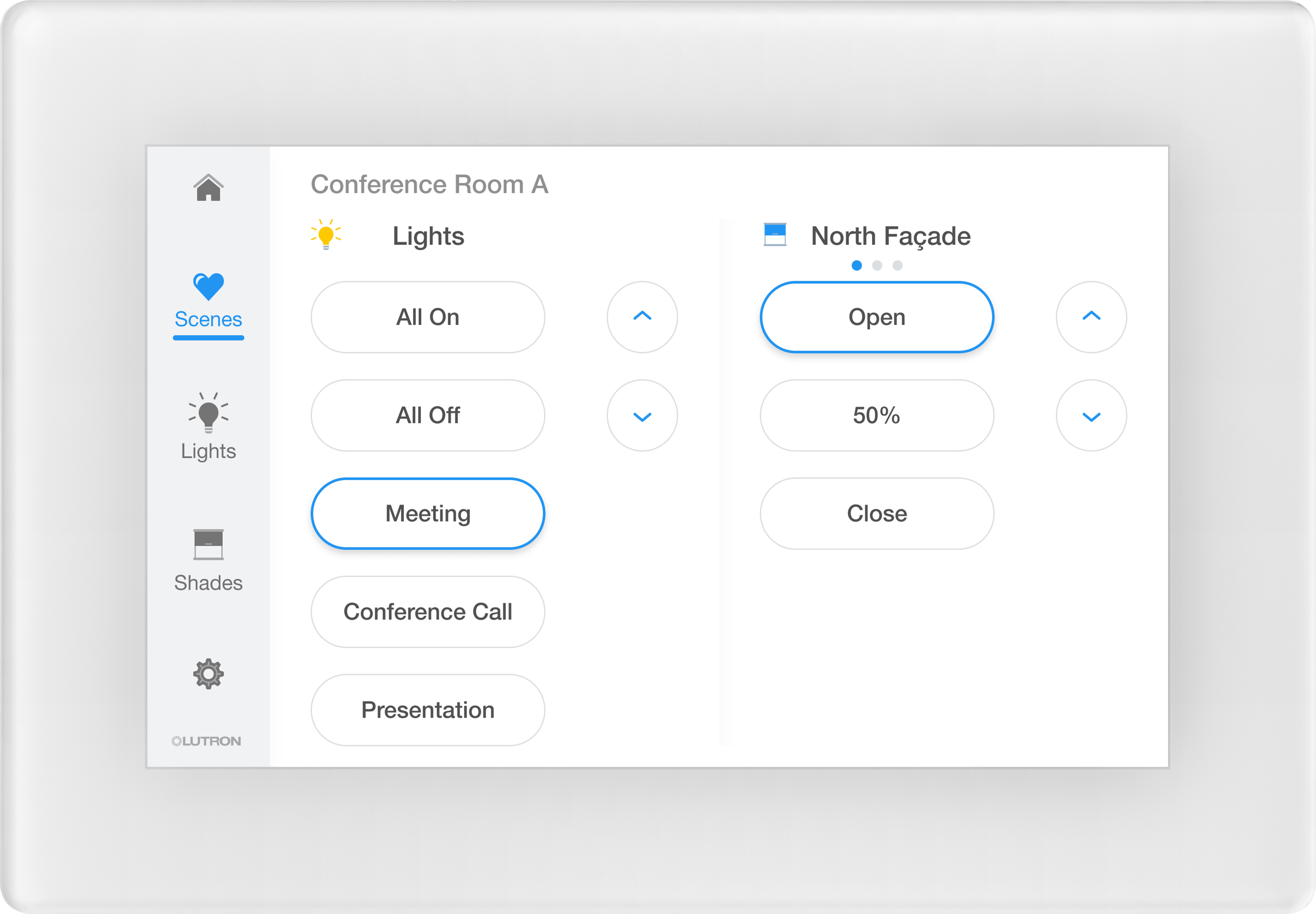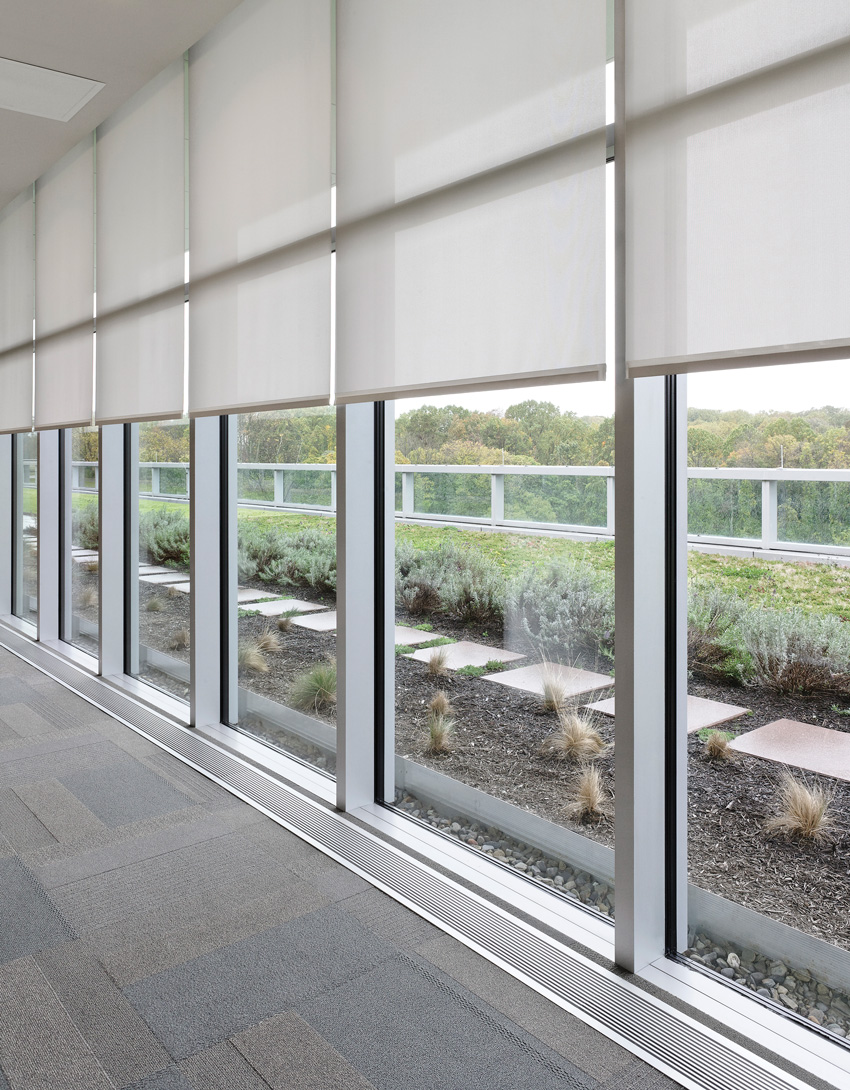Top Five Tips for Successful Daylighting Design
Tip #3: Choose Automated Controls
The type of control used by a daylighting system refers to how the physical technology (i.e., louver, electrochromic tint, fabric solar shade) is moved into and out of position. There are three categories of control from which specifiers have to choose: manual, motorized, and automated. The type of control selected for a project has a profound effect on the overall performance of the daylighting system.
Manual Control
Manual control requires that a person physically manipulate the position of the daylighting device. This traditional control approach has serious limitations in the level of daylighting performance it is able to provide because the positioning technology it relies upon is often unreliable. Energy savings, access to outdoor views, and comfort are readily compromised if the shade, louver, or electrochromic tint is not at its optimal position at any time throughout the work day. Unfortunately, the optimal position for these daylighting technologies changes constantly, and most of the people charged with the manual manipulation of a daylighting device are not interested in or available to tweak its position multiple times a day.
In determining the successful daylighting performance of a system, dynamic positioning is of paramount importance. Eastern exposures receive direct sunlight and may have a view of the sun’s orb during the morning hours, requiring that daylighting devices be lowered in the morning to manage glare and raised in the afternoon to allow ambient daylight inside. Western exposures have an opposite schedule, accessing soft, ambient light in the morning and receiving direct beam sunlight, and a direct view of the sun, as the sun sets in the afternoon. The sun’s daily path across the sky is not the only consideration for successful daylighting. Clear, sunny days can create overwhelming brightness at the window, regardless of the position of the sun, whereas, overcast days offer the softer, diffuse daylight that can be used without threat of glare from sunrise to sunset.
Unfortunately, positioning deficiencies are inherent in a manually operated system because effective daylighting is not top of mind for most employees in a building, nor would the employer want it to be. Manual operators are more likely to deploy a daylighting device to address discomfort (i.e., glare or heat) and then leave it in place, reducing the amount of ambient daylight allowed into their space. For example, it is common for people to completely pull down manual shades to control glare conditions they may be experiencing and then leave the shades down for days, weeks, or months. This single, static position severely limits the daylight and views benefit that can be realized in this space.
Motorized Technology with Manual Control
Motorized control is manual control at the touch of a button instead of the pull of the chain. Users can move single shades or banks of coordinated shades into preselected positions from keypads placed on the wall or by using wireless remote controls. Motorized control offers a clear aesthetic improvement over manual control in that the position of adjacent shades, or blinds, can now be consistent, creating a cleaner look. In terms of controllability, the different positions programmed onto the keypad may encourage users to select different positions beyond open and closed, which will allow some daylight into the space, even when the shades must be deployed to reduce the daylight level at the window or manage a direct view of the sun’s orb, but the system still requires manual manipulation throughout the day to create the balance of blocking glare-causing light and maximizing the usable daylight allowed into the space, when it is available. The manual aspect of a motorized system means that its performance can be extremely limited depending upon the attention the system is given by its handlers.

Photo courtesy of Lutron Electronics
Motorized control is manual control at the touch of a keypad or touchscreen, instead of the pull of a chain.
Of course, moving from manual to motorized also affects the total cost of the system. Exterior louvers are typically the most expensive solution, requiring custom system design and regular maintenance to address the issues caused by exposing a motorized system to the outdoor elements. While interior louvered systems do not battle wind, rain, or snow, they can be more expensive than expected because they require the use of two motors. One motor tilts the blades at the desired angle when the blind is deployed. The other motor provides the lift that retracts the louvered system when soft, ambient daylight is available. Motorized solar shades require only one motor to deploy and retract the fabric as needed, offering a more cost-effective motorized daylight management solution.
Automated Control
Automated controls are designed to precisely position the daylighting device for optimal daylighting performance. These systems use the known solar path of the sun to determine the optimal position of the shade or blind, or degree of tint on the glass, to manage glare caused by a direct view of the sun and continuously adjust to accommodate changes in solar angles. These systems can also have small wireless sensors placed near windows that detect the level of daylight entering a space and adjust the control device accordingly. This sensor placement enables the system to appropriately respond to overly bright days or overcast days.

Photo courtesy of Lutron Electronics
Automated shades move into precise and optimal positions throughout the day to protect the interior from glare and solar heat gain, while allowing usable daylight into the space when it is available.
Here is an example of how an automated shading system in a glass-clad building may function throughout the day. As the sun rises, the shades on the eastern exposure may deploy to a position halfway down the window to block the direct view of the sun from the workplane. The shades on the northern, southern, and western exposures may be entirely retracted to bathe the interior in gentle morning light. As the sun climbs higher in the sky, the shades on the eastern exposure may rise slowly, while the shades on the southern exposure deploy one-fourth of the way down the window, and the shades on the western and northern facades remain fully open. As it approaches noon, the shades on the southern exposure lower to the halfway position and the shades on the western facade lower to cover the top fourth of the window. In early afternoon, the shades on the eastern exposure are retracted completely, letting in the ambient afternoon light, and the shades on the southern and western sides deploy further to block the direct view of the sun and the direct sunlight it delivers. At sunset, all of the shades are fully open, allowing occupants to enjoy the soft light of early evening. All of this active daylight management occurred without anyone touching a button.
Lighting Energy Savings Comparison: Manual vs. Automated Shade Controls
Having a system that can maximize the presence of ambient daylight in a space also enables the lighting system to maximize the energy it can save when daylight is present. A study completed in collaboration with Lutron Electronics and Purdue University evaluated the difference in lighting energy savings that could be achieved with shading systems using manual and automated controls. The studied space was a perimeter private office with a lighting power density of 0.9 watt per square foot and standard, clear, double-pane glass. The same shading fabric was also used in both energy simulations, leaving the type of control used to manipulate the daylighting system as the only variable. Manual shades were defined as closed shades for the study. The singular position, although not ideal, was thought to more closely resemble actual manual shade operation than scenarios where manual shades are repositioned multiple times throughout the day. The team concluded that an automated shading system was able to reduce the electric light use in the private office by 83 percent more than the same space when the windows were outfitted with manual shades. For more information about this study on energy savings click here or visit www.performanceshadingadvisor.com/LutronResources/pdf/energySavings.pdf.









